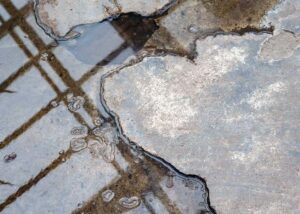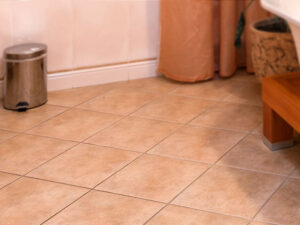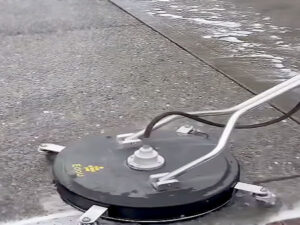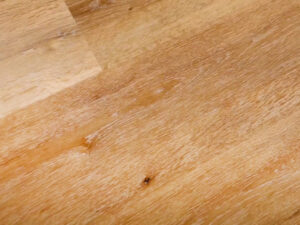Clean dog urine from tile grout by blotting up excess liquid, then applying a mixture of water and vinegar. Scrub the area with a grout brush and rinse with warm water.
Dealing with pet accidents on your flooring can be frustrating, especially when it permeates the porous spaces of tile grout. The key to maintaining a fresh and sanitary environment in your home is addressing pet urine stains immediately. As a pet owner, learning the most efficient ways to tackle these accidents ensures that your tiled areas remain spotless and odor-free.
The use of common household ingredients like vinegar not only neutralizes odors but is also gentle on your tiles, making it an excellent go-to solution. Following a straightforward cleanup method ensures that you quickly restore your floors to their original state, keeping your home hygienic and welcoming for both humans and pets alike.
Understanding Dog Urine & Tile Grout
Cleaning dog urine from tile grout is not just about odor control; it’s also about maintaining a clean and hygienic living space. Understanding the nature of dog urine and the material of your grout can be incredibly beneficial in effectively tackling stains and odors. Grout, due to its porous quality, can absorb liquids and lead to stubborn stains. As a pet owner, it’s essential to arm yourself with knowledge and the right techniques to prevent long-term damage to your flooring.
The Chemical Composition Of Dog Urine
Dog urine contains a combination of urea, creatinine, uric acid, sodium, and other electrolytes. It’s this chemical makeup that can cause urine to leave behind an unpleasant smell and stain if not cleaned promptly. Uric acid, in particular, is responsible for the stubborn nature of urine stains as it can recrystallize and release odors over time.
Porous Nature Of Grout And Staining Potential
Grout is considerably porous, making it susceptible to absorption and discoloration. When dog urine seeps into the grout, it can cause permanent staining and damage if not addressed quickly. Knowing the type of grout you have is key, as sanded grout is more porous than unsanded or epoxy grout, affecting the cleaning method you should use.
Potential Health Hazards If Not Cleaned Properly
Ignoring dog urine on tile grout can present several health risks. Urine can harbor bacteria, leading to unhealthy living conditions. The longer urine sits, the more it encourages microbial growth, potentially resulting in allergies, unpleasant smells, and a compromised immune system, especially in children and those with weakened immunity.
Signs Of Urine In Grout
Detecting signs of urine in grout is a critical step in maintaining a clean and odor-free home, especially for pet owners. While tile surfaces are often easy to wipe down, the porous nature of grout can trap urine, leading to stains and unpleasant smells. Understanding the visual and non-visual signs of contamination is key to effectively cleaning and deodorizing your floors.
Visible Staining Versus Unseen Contamination
Grout’s porous material can absorb liquids, including dog urine, which often leads to visible staining. These stains might appear as discolored patches against your grout’s natural color. However, not all signs of urine are visible to the naked eye. Sometimes, urine seeps deep into the grout, causing unseen contamination that can only be detected by the persistent odor or using specific detection methods.
Detection Methods For Urine Presence
To uncover the extent of urine contamination within tile grout, pet owners can employ a few effective detection methods:
- UV Light: A blacklight or UV light can be used in a dark room to illuminate urine stains that are invisible under regular lighting.
- Odor Detection: Sometimes, the sense of smell may be the only indicator. Sniff tests in suspect areas can help identify where cleaning is needed.
- Moisture Meters: These devices can detect dampness in grout, which may indicate urine that has not yet dried or set.
Note: For complete eradication of urine from tile grout, it is crucial to not only treat the visible signs but also apply cleaning solutions that tackle the unseen contamination.
Initial Cleaning Steps
Welcome to the crucial first chapter in the mission to reclaim the pristine state of your tile grout from unexpected dog urine accidents. Acting quickly and efficiently is key to preventing permanent stains and odors. Let’s begin by walking through the essential initial cleaning steps, vital for laying the groundwork for a spotless, odor-free floor.
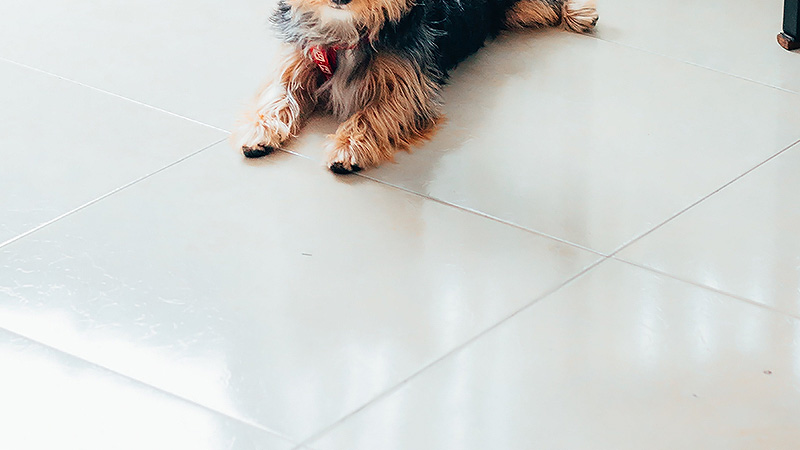
Removing Excess Urine From Tiles
First and foremost, quick action is paramount. Upon discovering the mishap, remove as much urine as possible before it penetrates deeper into the grout. For this, you’ll need to absorb the liquid directly from the tiles.
- Locate all affected areas, ensuring nothing goes unnoticed.
- Use paper towels or an absorbent cloth to gently press down on the wet spots.
- Continue until no more liquid can be lifted from the surface.
Blotting Technique Instead Of Wiping
During the cleaning process, the blotting technique is your best ally. Avoid the urge to wipe as this only spreads the urine and can push the liquid deeper into the grout. Gentle blotting action is essential; this ensures the urine is absorbed into your cleaning material rather than being smeared across more tiles.
- Place the absorbent material over the affected area.
- Apply pressure with the palm of your hand or step on it gently.
- Lift straight up; do not drag the cloth across other tiles.
Preparing The Area For Deep Cleaning
With the excess moisture now out of the way, it’s time to prepare for the deeper cleaning process. Ensuring the area is ready for this next step is instrumental in eliminating any lingering odors and stains.
- Wipe down the entire affected area with clean water to remove any remaining urine on the surface of the tiles.
- Pat the area dry with a clean towel.
- Prepare your chosen cleaning solution suitable for tiles and grout. Make sure it’s at hand for the following deep clean phase.
Sticking to these initial cleaning steps will greatly improve your chances of restoring your tiled floor to its former glory. In the following sections, we’ll delve into the specifics of the deep cleaning process and share some pro tips for maintaining your grout over the long term.
Choosing The Right Cleaning Solution
When it comes to tidying up after our canine companions, choosing the right cleaning solution is crucial for maintaining both hygiene and the integrity of your home surfaces. Cleaning dog urine from tile grout can prove to be a challenging task. While tiles may be impermeable, grout is porous, and thus can absorb odors and stains. To effectively tackle this chore, you’ll want to arm yourself with an optimal cleaner that not only neutralizes odors but also safeguards your grout against damage.
Clean Dog Urine From Tile Grout With Homemade Solutions
Homemade concoctions are not only cost-effective but also minimize the exposure to harsh chemicals. To commence your cleaning venture, consider these proven homemade mixtures:
- Baking Soda and Vinegar: This eco-friendly duo is renowned for its cleaning prowess. Begin by sprinkling baking soda on the grout lines, followed by a spray of white vinegar. Allow the fizzing reaction to lift the stain before scrubbing.
- Hydrogen Peroxide: As a mild bleaching agent, hydrogen peroxide can be directly applied to the stained areas. An application with a spray bottle ensures even coverage.
- Lemon Juice: Its natural acidity makes lemon juice an excellent choice for grout cleaning. Apply, let it sit, and then scrub gently to avoid eroding the grout.
Whichever solution you opt for, test it on a small hidden section first to ensure it doesn’t discolor or damage the grout. After applying the cleaner, let it dwell for several minutes before scrubbing with a brush specifically designed for grout. Rinse the area thoroughly with water and pat dry with a clean towel.
Commercial Cleaners Specifically for Urine and Grout
Commercial Cleaners Specifically For Urine And Grout
For those seeking ready-to-use options, numerous commercial cleaners are formulated to specifically target urine odors and stains on grout. These products typically contain enzymes or bacteria that break down urine compounds and eliminate odors at the source. Key considerations include:
| Commercial Cleaner | Active Ingredients | Suitability for Grout |
|---|---|---|
| Enzymatic Cleaner | Enzymes, Non-toxic Surfactants | Yes |
| Oxygen-based Bleach | Oxygen Bleach (Hydrogen Peroxide Derivatives) | Yes, with care |
| Specialty Urine Remover | Specialized Enzyme or Bio-based Formulas | Recommended |
After choosing the appropriate commercial cleaner, adhere to the manufacturer’s instructions for application and bear in mind that prolonged contact with the grout might be necessary for tougher stains. Always rinse thoroughly post-cleaning, as residue can attract dirt.
The Cleaning Process Explained
When your furry friend has an accident on your tiled floor, it’s essential to tackle the mess quickly and effectively to prevent lasting stains and odors. Grout, being porous, can absorb urine and trap the odor. To restore your tiles to their pristine condition, follow this detailed cleaning guide, tailored to address the challenges of dog urine in grout lines.
Detailed Application Of Chosen Cleaner
Begin by selecting an enzyme-based cleaner, specifically designed for pet stains. These cleaners break down the proteins in urine, ensuring a deep clean that ordinary detergents can’t achieve. To apply:
- Saturate the stained grout with the cleaner.
- Allow the solution to soak for 5-10 minutes to penetrate the grout.
- If the grout line is dry after this period, add more cleaner. The grout should remain wet throughout the cleaning process.
Scrubbing Technique For Effective Removal
After the cleaner has soaked in, it’s time to get hands-on. The goal is to agitate the cleaner within the grout lines to lift the urine residue.
- Use a stiff-bristled brush to scrub the affected area vigorously, paying extra attention to discolored sections.
- Maintain consistent pressure and circular motions to ensure comprehensive coverage.
- Extend the scrubbing beyond the visible stain to catch any unnoticed urine spread.
Rinsing And Repeating As Necessary
The final step involves a thorough rinse with clean, warm water to remove all remnants of the cleaner and the dissolved urine. Follow these steps:
- Mop up the area with a damp cloth or sponge to remove the cleaning solution.
- Pat dry with a towel or use a wet-dry vacuum if available, to expedite drying.
- Examine the grout. If odors or stains persist, repeat the process.
Remember, persistence is key. In some cases, multiple applications are necessary to fully eliminate the odor and discoloration.
Addressing Persistent Stains
Dog urine not only leaves an unwanted odor but can also discolor your tile grout. When household remedies and initial cleaning attempts don’t cut it, tackling persistent stains becomes a necessity. Over time, the acidic nature of urine can seep into grout lines, creating stains that are resistant to regular mopping and spot cleaning. These stains require a more strategic approach to restore the appearance of your tile grout. Let’s delve into the solutions that are tailored for these long-standing, stubborn stains to ensure your floors return to their former glory.
Long-term Staining Solutions
Durable, long-term solutions are vital for maintaining a clean and hygienic tile surface. To combat these tough stains, consider the following:
- Enzymatic Cleaners: Specially designed to break down the proteins in urine, these cleaners can be particularly effective for deep-set stains.
- Oxygen Bleach: A safe alternative to chlorine bleach that can be used for grout. It’s gentle yet effective in whitening grout lines.
- Professional Strength Grout Cleaners: These are formulated to tackle the toughest of stains and may offer a more powerful solution.
- Sealants: Once the grout is clean, applying a sealant can prevent future urine from penetrating the porous surface.
Strategies For Challenging Grout Lines
Challenging grout lines, due to their porous nature and often lighter color, can be especially susceptible to staining. Follow these strategies to ensure effective cleaning:
- Appropriate Tools: Utilize a stiff-bristled brush for scrubbing the grout. This type of brush can help dislodge urine particles from the grout lines.
- Targeted Application: Apply the cleaning solution directly to the grout. Leave it to soak for several minutes to penetrate the stain before scrubbing.
- Consistent Maintenance: Regular cleaning and prompt attention to accidents help prevent urine from causing long-term discoloration.
- Trial and Error: Be willing to try different products and techniques. Sometimes the solution requires a combination of approaches.
Remember, patience and persistence are key in tackling these stubborn grout stains.
Preventing Grout Stains Future
Whether you’re a seasoned dog owner or new to the game, managing the occasional indoor accident is a part of life. But when it comes to preserving the pristine look of your tile grout, taking preventative steps can save both time and effort in the long run. Let’s explore practical measures you can implement to shield your grout from those unexpected urine stains and maintain the beauty of your floors.
Daily Maintenance Tips To Prevent Urine Staining
Maintaining a stain-free grout begins with daily habits that deter the accumulation of dirt, debris, and potential pet accidents:
- Immediate Cleanup: Swiftly wipe up any spills or accidents to prevent seepage
- Regular Sweeping: Sweep floors to clear away debris that could harbour urine residue
- Mopping: Use a gentle cleaning solution regularly to keep tile and grout clean
- Pet Training: Consistent pet training reduces the likelihood of indoor accidents
- Barrier Mats: Place mats in pet-frequented areas to soak up any mess before it reaches the grout
Staying vigilant with these simple actions will be instrumental in maintaining a spotless tiled area, keeping those grout lines free from unsightly blemishes.
Grout Sealing For Stain Prevention
One of the most effective defenses against grout staining is the application of a sealer. This is a key step in guarding porous grout lines:
- Clean the grout thoroughly before sealing
- Choose a quality grout sealer suitable for your tile and grout type
- Apply the sealer evenly, following the manufacturer’s instructions
- Allow ample drying time before exposing the area to moisture
- Reapply periodically, as its effectiveness may diminish over time
Sealed grout not only resists staining but also prolongs the overall integrity of your tiled surfaces. With these precautions in place, your tiles will not only stay cleaner but will also be easier to maintain in the face of life’s little messes.
Embracing these preventative practices will help ensure that your grout stays pristine and the charm of your tile floors endures despite the occasional pet mishap.
Responding To Accidents Quickly
Responding to Accidents Quickly is key when dealing with dog urine on your pristine tile grout. Accidents can happen, but it’s the swift and decisive action that can stop a simple cleanup job turning into a grout renovation project. Urine can seep into the grout, causing not only discoloration but also unpleasant odors and potential long-term damage if not treated promptly. Let’s dive into the steps you should take immediately post-incident and discuss why acting quickly is vital for maintaining the health of your grout.
Steps For Immediate Action Post-accident
- Blot the area: Use paper towels to blot up as much urine as possible. Avoid rubbing to prevent the urine from penetrating deeper into the grout.
- Apply cleaning solution: Mix a solution of 1 part white vinegar to 1 part water. Pour this mixture over the stained grout and let it sit for a few minutes to break down the urine.
- Scrub the grout: With an old toothbrush or a grout brush, gently scrub the affected area to loosen the urine particles from the grout.
- Rinse thoroughly: Rinse the area with clean water and remove the cleaning solution completely.
- Pet-specific enzyme cleaner: It’s wise to follow up with a pet-specific enzyme cleaner which targets urine odors and stains, ensuring all traces are eliminated.
- Dry the area: Use a clean towel or a mop to dry the tile and grout to prevent any remaining moisture from sitting too long.
Importance Of Prompt Cleaning For Grout Health
Immediate cleaning after a dog urine accident is crucial for maintaining grout integrity. Grout, being porous, can absorb liquids quickly, which can lead to staining, lingering odors, and even deterioration over time. Here are key reasons to act without delay:
- Prevent staining: Dog urine can leave behind unsightly yellow stains that can be much harder to remove if they set in.
- Avoid odors: As urine breaks down, it releases ammonia and other compounds that can leave a lasting, unpleasant smell.
- Structural integrity: Prolonged exposure to acids in the urine can weaken the grout, leading to crumbling or the need for repair.
- Hygiene: Urine is not hygienic and can breed bacteria if not cleaned properly and promptly.
Cleaning up accidents swiftly does more than just keep your floor looking clean; it preserves the functionality and appearance of the tile grout for years to come. Protect your grout by acting fast and following the outlined steps to ensure a thorough clean.
Conclusion
Cleaning dog urine from tile grout can be daunting, but it’s achievable with the right steps. By using household items or specialized cleaners, your floors can look and smell fresh again. Remember, swift action and proper techniques make all the difference.
Keep your furry friends happy and your tiles pristine with these simple solutions.


